
Christian IX was King of Denmark from 15 November 1863 until his death in 1906. From 1863 to 1864, he was concurrently Duke of Schleswig, Holstein and Lauenburg.

Frederick I was King of Denmark and Norway. He was the last Catholic monarch to reign over Denmark and Norway, when subsequent monarchs embraced Lutheranism after the Protestant Reformation. As king of Norway, Frederick is most remarkable in never having visited the country and was never crowned as such. Therefore, he was styled King of Denmark, the Vends and the Goths, elected King of Norway. Frederick's reign began the enduring tradition of calling kings of Denmark alternatively by the names Christian and Frederick.
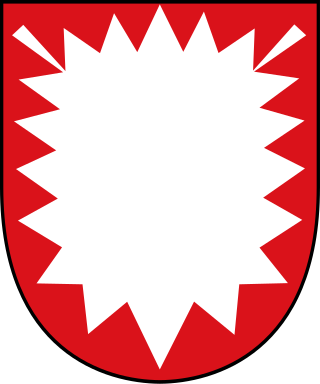
Holstein is the region between the rivers Elbe and Eider. It is the southern half of Schleswig-Holstein, the northernmost state of Germany.
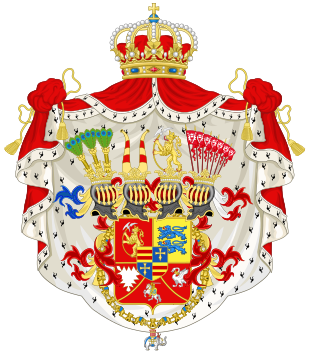
The House of Schleswig-Holstein-Sonderburg-Glücksburg, better known as the House of Glücksburg, is a branch of the German House of Oldenburg. Oldenburg house members have reigned at various times in Denmark, Norway, Sweden, Iceland, Greece, and several northern German states.

Holstein-Gottorp is the historiographical name, as well as contemporary shorthand name, for the parts of the duchies of Schleswig and Holstein, also known as Ducal Holstein, that were ruled by the dukes of Schleswig-Holstein-Gottorp, a side branch of the elder Danish line of the German House of Oldenburg. Other parts of the duchies were ruled by the kings of Denmark.

The House of Oldenburg is an ancient dynasty of German origin whose members rule or have ruled in Denmark, Iceland, Greece, Norway, Russia, Sweden, the United Kingdom, Livonia, Schleswig, Holstein, and Oldenburg. The current King of the United Kingdom and King of Norway are agnatic members of this house, meanwhile the King of Spain and King of Denmark are matrilineal members.

Charles Frederick, Duke of Schleswig-Holstein-Gottorp was a Prince of Sweden and Duke of Schleswig-Holstein-Gottorp and an important member of European royalty. His dynasty, the Dukes of Schleswig-Holstein-Gottorp, were a cadet branch of the ancient House of Oldenburg, which at that time was ruling Denmark-Norway. His mother was a sister of Charles XII of Sweden. Charles Frederick married a daughter of Peter the Great and became the father of the future Peter III of Russia. As such, he is the progenitor of the Russian imperial house of Holstein-Gottorp-Romanov and the patrilineal ancestor of all Russian emperors starting with Peter III, except for Catherine II.

Gottorf Castle is a castle and estate in the city of Schleswig, Schleswig-Holstein, Germany. It is one of the most important secular buildings in Schleswig-Holstein, and has been rebuilt and expanded several times in its over eight hundred years of history, changing from a medieval castle to a Renaissance fortress to a Baroque palace.
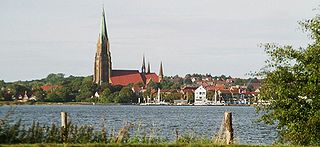
Schleswig Cathedral officially the Cathedral of St. Peter at Schleswig, is the main church of the city of Schleswig and was the cathedral of the Bishop of Schleswig until the diocese was dissolved in 1624. It is now a church of the North Elbian Evangelical Lutheran Church, the seat of the Lutheran Bishop of Schleswig and Holstein, and ranks among the most important architectural monuments of Schleswig-Holstein.

Frederick IV was the reigning Duke of Holstein-Gottorp.

Frederick III of Holstein-Gottorp was a Duke of Holstein-Gottorp.
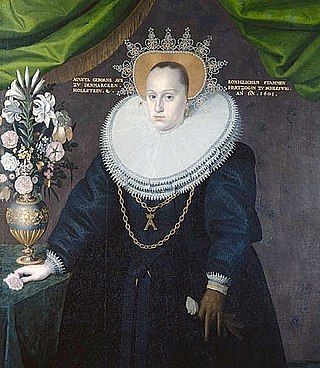
Princess Augusta of Denmark was the Duchess of Holstein-Gottorp as the wife of Duke John Adolf. She was the third daughter of King Frederick II of Denmark and Sophia of Mecklenburg-Güstrow. She was politically influential during the reign of her son, Duke Frederick III.

Adolf of Denmark or Adolf of Holstein-Gottorp was the first Duke of Holstein-Gottorp from the line of Holstein-Gottorp of the House of Oldenburg.

The Duchy of Holstein was the northernmost state of the Holy Roman Empire, located in the present German state of Schleswig-Holstein. It originated when King Christian I of Denmark had his County of Holstein-Rendsburg elevated to a duchy by Emperor Frederick III in 1474. Members of the Danish House of Oldenburg ruled Holstein – jointly with the Duchy of Schleswig – for its entire existence.

Jürgen Ovens, also known as Georg, or Jurriaen Ovens whilst in the Netherlands, was a portrait painter and art-dealer from North Frisia and, according to Arnold Houbraken, a pupil of Rembrandt. He is best known for his painting in the city hall of Amsterdam and paintings for the Dukes of Holstein-Gottorp for whom he worked for more than 30 years, also as an art dealer.
Holstein-Glückstadt or Schleswig-Holstein-Glückstadt is the historiographical name, as well as contemporary shorthand name, for the parts of the duchies of Schleswig and Holstein that were ruled by the Kings of Denmark in their function as dukes of Schleswig and Holstein, thus also known as Royal Schleswig-Holstein. Other parts of the duchies were ruled by the Dukes of Schleswig-Holstein-Gottorp. The territories of Holstein-Glückstadt are located in present-day Denmark and Germany. The main centre of administration was Segeberg and from 1648 Glückstadt on the River Elbe.

Schleswig-Holstein-Sonderburg was the name of a branch line of the House of Oldenburg as well as the name of their land. It existed from 1564 until 1668 and was a titular duchy under the King of Denmark, rather than a true territorial dukedom in its own right. The seat of the duke was Sønderborg. Parts of the domain were located in Denmark, mainly on the islands of Als and Ærø and around Glücksburg, whilst other lands were part of the Holy Roman Empire, including the Ämter of Plön, Ahrensbök, and Reinfeld. As a result of various inheritance arrangements it fragmented into numerous small territories which were eventually absorbed into Greater Denmark in the 18th century.
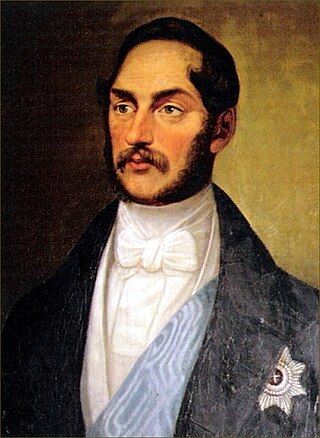
Karl, Duke of Schleswig-Holstein-Sonderburg-Glücksburg was Duke of Schleswig-Holstein-Sonderburg-Glücksburg from 1831 to 1878. Karl was the eldest son of Friedrich Wilhelm, Duke of Schleswig-Holstein-Sonderburg-Glücksburg, and Princess Louise Caroline of Hesse-Kassel and an elder brother of Christian IX of Denmark.

Plön Castle in Plön is one of the largest castles in the north German state of Schleswig-Holstein and the only one located on a hill. The former Residenz of the Dukes of Schleswig-Holstein-Plön was built in the 17th century during the Thirty Years War and has had a colourful history in which it has, for example, been a school for military cadets and also a boarding school.

Frederick Ernest of Brandenburg-Kulmbach was a member of the Brandenburg-Kulmbach branch of the House of Hohenzollern. His most significant position was governor of the Duchies of Schleswig and Holstein-Glückstadt.


















